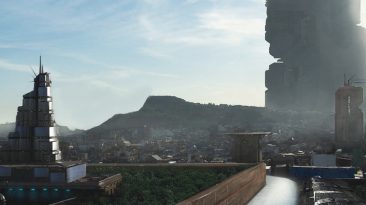With nearly eight billion people on the planet, things can feel pretty crowded. Let’s make things a bit tighter by housing every single person on Earth in one giant skyscraper. Pack up your things, we’re all moving in together. But a building big enough for all eight billion of us doesn’t exist yet.
We’re going to have to build one from the ground up. And before we do, let’s start small and work our way up with one that could hold at least a country or two. We’ll start with some of the least populated countries and move on to the most gigantic skyscraper Earth has ever seen. Could that one reach the Moon?
Building a skyscraper to house billions of people would be no easy feat. You’d need to use the most high-tech materials possible. Because with the heights that you’re about to conquer, you’d be facing intense gravitational forces pulling on your megabuilding.
You’d want something as strong, or stronger, than diamonds to handle all that pressure. And it has to be extremely light and flexible too. Because if your skyscraper is too massive, the ground below might not support its weight. It would create a ditch in the planet’s crust.
Eventually, your skyscraper would sink deeper and deeper until it disappeared underground. Well, you don’t want all your effort to go to waste, right? Fortunately, the first skyscraper you’d build wouldn’t compare to your final goal. But it would be tall enough to hold the entire population of Iceland.
ICELAND
For this experiment, you’d be housing 10,000 people on each floor. And that would make your Iceland building almost half as tall as the Eiffel Tower in Paris. That’s not as exciting as some of our next skyscrapers are about to get. And it would only take you just over two minutes to get to its top floor. Which would be floor 34. Still, it would be a good practice for you to figure out the infrastructure to support all your residents.
AUSTRALIA
Next on the list, Australia skyscraper. Now that’s where things get interesting. Because at 10 km (6.2 mi), this building would be taller than Mount Everest. Next on the list, Australia skyscraper. Now that’s where things get interesting. Because at 10 km (6.2 mi), this building would be taller than Mount Everest. And to commute all the way to the top of your Australia skyscraper, you’d have to spend two hours and 40 minutes one-way. And that’s nothing compared to our next engineering feat.
UNITED KINGDOM
To shelter every resident of the UK, you’d need to think bigger than Big Ben’s height. Like almost 300 times bigger. Your UK skyscraper would have a whopping 6,800 floors. It would reach a height of 27 km (17 mi). And after floor 4,500, you’d now be above the clouds.
PHILIPPINES
The Philippines is home to over one hundred million people. And to house all of them, your skyscraper would need to be 40 km (24.8 mi). This man-made monolith would have 10,000 floors. And most of it would be above the clouds. It would take you 11 hours to get to the top floor of the Philippines skyscraper. So hopefully you don’t have to come down all that often.
MEXICO
Moving on up to something a little taller, your Mexico building would be a jaw-dropping 52 km (32.3 mi). That’s twice as tall as the tallest mountain in the Solar System, Olympus Mons on Mars. It would take you 14.5 hours to travel all the way to its 13,000th floor. Once there, you’d be halfway to outer space. But at least you’d still have the atmosphere around you. I can’t say that about your next megastructure.
THE U.S.
The U.S. skyscraper would be really, really tall, reaching a height of 132 km (82 mi). And after floor 25,000, you’d be officially in space. Pretty cool, huh? But only if you don’t think about the wild temperatures just outside your window. The top of this building would be in the thermosphere. And contrary to what you might think, this layer is incredibly hot, rising to 2,500 °C (4,500 °F).
But if you were to open a window, you’d feel cold. All because in this layer of our atmosphere there are not enough air molecules to transfer the heat to you. Oh, and that would also make breathing impossible. So you’d really need to focus on installing a proper oxygen support system for the penthouse tenants to survive.
INDIA
On to one of the most populated countries in the world. India skyscraper would be unimaginably tall, reaching a height of 552 km (343 mi). That’s 138,000 floors. And to get to the top, you should expect a travel time in excess of six days. If I lived way up there, I don’t think I’d ever go down.
India skyscraper would be taller than the orbit of satellites and even the International Space Station. Now that you’d be in space, you’d really need to build proper oxygen, water and waste systems. You’d have to think about how to feed all those people, because transporting food from the ground would be virtually impossible.
And now, to the tallest skyscraper of all time, the super megastructure that would hold all eight billion of us. The Earth Tower.
THE EARTH TOWER
The Earth Tower might not reach the Moon, but it would be almost as tall as the Moon’s diameter. This incredible structure would have 800,000 floors. And it would peak at a mind-boggling 3,200 km (1,990 mi). Depending on where you’d live here, you’d see planes, satellites and the ISS.
It’s somewhat ironic that most of Earth Tower would be in space, well above our planet’s atmosphere. Forget about a balcony with a view of the Moon. You wouldn’t want to go outside unless you were wearing a spacesuit. Now let’s talk about trying to piece the tower together.
In addition to its own weight, it would need to support the weight of the entire global population. At about 356 million tons, this would already be nearly 1,000 times heavier than the Empire State Building. To provide everyone with clean water, add to that the equivalent of 4.5 million Olympic-sized swimming pools that will be consumed every day. And I’m not even talking about food or other essential stuff here.
The lower floors of this megastructure would be dark and gloomy. There’d likely be high crime rates as people did whatever it takes to survive. The top floors would belong to the rich. They’d be dependent upon the work of these lower levels. Life would certainly be complicated in our giant new skyscraper. Infectious diseases could spread at never-before-seen speeds.
Overcrowding would lead to widespread mental health issues. But at least you’d have an incredible amount of room outdoors on the ground level to enjoy with everyone in one building. Only your elevator commute from the very top floor to the bottom would take you about 37 days. Maybe things could be worse than living way high up in the sky? Every single person could live underground.
Sources
- “Is There a Limit to How Tall Buildings Can Get?”. Nate Berg. 2012. bloomberg.com
- “Mount Everest | Height, Location, Map, Facts, Climbers, & Deaths”. 2022. britannica.com.
- “X-Seed Inspires Tall Tales”. Sam Lubell. 2007. architecturalrecord.com.
- “X-SEED 4000: World’s tallest tower will house 1 million people”. Yuka Yoneda. 2007. inhabitat.com.
- “Explainer: Our Atmosphere — Layer By Layer”. 2020. snexplores.org.



























